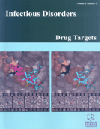-
oa Anti-Pathogenic Efficacy and Molecular Targets of a Polyherbal Wound-Care Formulation (Herboheal) Against Staphylococcus aureus
- Source: Infectious Disorders - Drug Targets (Formerly Current Drug Targets - Infectious Disorders), Volume 19, Issue 2, Jun 2019, p. 193 - 206
-
- 01 Jun 2019
Abstract
Background: A polyherbal formulation (Herboheal) traditionally indicated for woundcare was investigated for its anti-virulence potential against the notorious pathogen Staphylococcus aureus. Objective: This study aimed at evaluating anti-virulence potential of Herboheal formulation against S. aureus in vitro as well as in vivo, followed by studying its effect on target bacterium’s gene expression at the whole transcriptome level. Methods: In vitro efficacy of the test formulation was evaluated using broth dilution assay, whereas in vivo efficacy was assayed employing the nematode Caenorhabditis elegans as the model host. Molecular targets of the test formulation in S. aureus were elucidated through whole transcriptome analysis. Results: This formulation could exert inhibitory effect on bacterial growth and quorum sensingregulated pigment (staphyloxanthin) production at ≥ 0.025% v/v. It not only could inhibit S. aureus biofilm formation, but also eradicated pre-formed biofilm effectively. This formulation could modulate antibiotic susceptibility of S. aureus, enhanced its susceptibility to human serum heavily, while compromising its haemolytic potential. Herboheal-treated bacteria expressed notably lesser virulence towards the nematode worm Caenorhabditis elegans. Even repeated exposure of S. aureus to this polyherbal formulation did not give rise to resistant phenotype. Whole transcriptome analysis revealed genes associated with hemolysis, virulence, enzyme activity, transport, basic cellular processes, quorum sensing, and transcriptional regulators as the major targets of Herboheal in S. aureus. Conclusion: This study validates the traditional use of Herboheal formulation in wound-care by demonstrating its efficacy against one of the pathogenic bacteria most commonly involved in wound infections.


